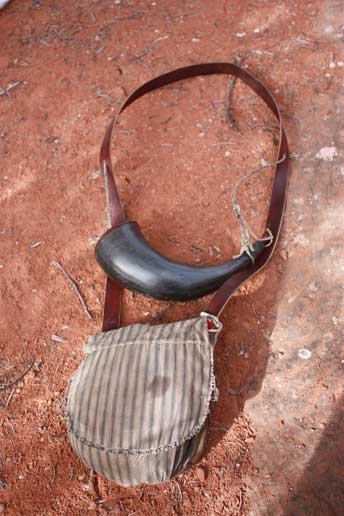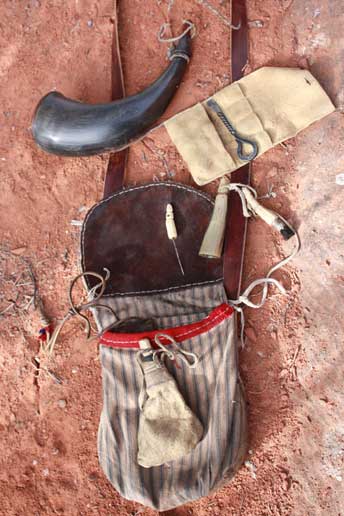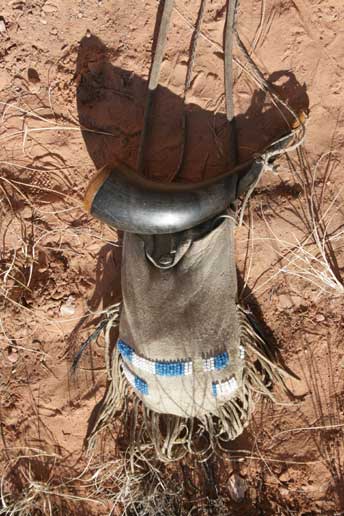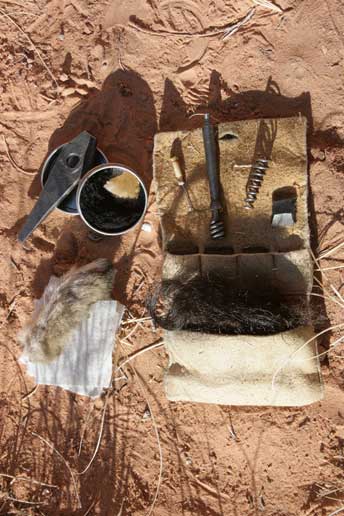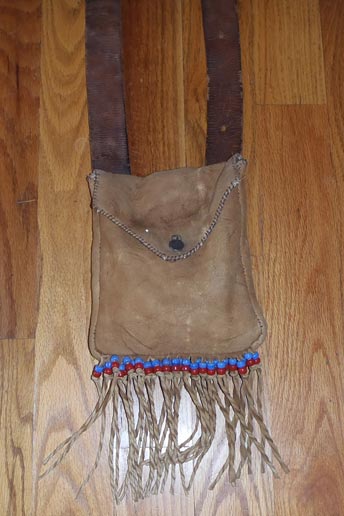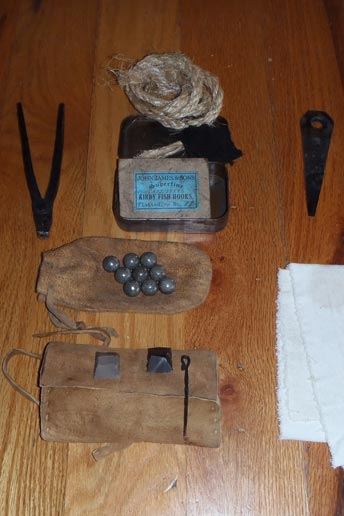Rocky Mountain Outfit — American Mountain Men (AMM) party of Colorado
What's In Your Bag?
This article is a look inside the shooting bags carried by members of the Rocky Mountain Outfit. This is something that we share with each other during our camps. It is always interesting to see what other guys find necessary to carry in their bags. It is also a great way to teach new folks that there is really no need for any modern items to be hiding in their bags.
Shooting a muzzleloader does not have to be a complex endeavor with all kinds of gadgets. For instance, do you really need to carry that lead ladle and ball mold with you at all times? No, that is something you can keep packed with your other camp supplies. Think about what you really need and lighten the load. It will be easier to find things in your bag and your shoulders will thank you for it.
Bill Gantic
Over the years I have used a couple different styles of shooting bags. One was of oiled harness type leather. It would get stiff and was too large for my liking. What I have settled on is one of my own making. The basis for this one is from some of the typical bags seen in Alfred J. Miller paintings and from what I want in a shooting bag. I use the same bag for my rifle and my northwest trade gun; I just change out what I have inside, which isn't much.
This bag is manufactured from pillow ticking on which I rubbed in warmed bees wax. It is of the typical "D" shape and measures 7 1/2" by 7 1/2". It has a 1 1/2" crescent shaped gusset of brain tanned deer hide in the bottom. The inside of the flap is reinforced with thin oil tanned leather in order to give shape and to help hold it in place. Inside, on the back of the bag, is sewn a small pocket of ticking. The strap is non-adjustable 3/4" oil tanned leather. My buffalo powder horn is simply attached to the strap with braided brain tanned whangs. I prefer this way of attaching the horn to the bag over having the horn separate because it keeps the horn and bag together at all times. One never knows when they might have to grab their bag and rifle in the middle of the dark night and make a run for it. It also keeps me from having too many straps hanging around my neck.
The following image is my typical setup for my rifle. From the top to bottom is: buffalo powder horn, brain tanned flint wallet with a forged screwdriver. In the wallet pocket is a worm with shirt material or buffalo hair for cleaning and/or patching. Next is a steel vent pick which I stick into the bags material, a powder measure made from a cow horn tip and a horse hair pan brush. Both are attached to the bag's strap with a brain tan whang. Inside the bag is a leather ball bag. When I am hunting I leave this out and instead place a few balls in the flint wallet and a couple in the bag's inner pocket. The next item is a brain tan shot bag for carrying loose lead shot. The spout is made from the leftover tip from my buffalo powder horn. I have even used shot in my rifle with good results.
Bradley C Bailey
My bag was patterned after the bag shown in the A.J. Miller painting "Trappers Starting for the Beaver Hunt." It is about 6" by 9" and of a simple Indian construction, made from brain tanned elk hide without a lining, and sewn with backstrap sinew. No gusset was used because brain tan has more give and stretch than other leathers. It has fringe along the bottom and two lines of a simple alternating beadwork pattern of blue and white pound beads, though with hard use many are now missing. The inside of the bag contains a small pocket about 5" by 3". The non-adjustable strap is of 3/4" elk hide and keeps my bag up higher so I can keep it in place with my elbow and it doesn't bounce around on the saddle. I use this bag for both my 58cal J.Henry Lancaster rifle as well as my 20ga early Pennsylvania smoothbore.
My horn is made of a buffalo horn and patterned after one displayed in the Museum of the Fur Trade. The spout and base plugs are made from pine with a tobacco stain and linseed oil finish. A powder measure is attached to the horn with a whang and is tucked away inside my bag when it is worn. The horn strap is braided braintan like many shown by Miller. Having a separate strap for the horn definitely has disadvantages such as getting tangled with the bag strap, but it is something that is shown quite frequently in the Millers and allows you to carry both your bag and horn on different sides. After wearing my bag and horn many different ways I finally settled on keeping them both together on my right side. Having the horn on the right side makes it easy for me to use to prime my pan since I do not carry any kind of special priming horn.
The typical contents of my bag is as follows: A handful of loose balls and patching at the bottom of the bag where I can easily reach in and find them rather than fiddling with another bag. The inner pocket of my shooting bag holds my hunting license (we still have to follow the law), vent pick made from a coyote toe bone, and some pre-cut patches for quick access. A flint wallet with spare flints, a forged worm, a wire worm, and buffalo hair for cleaning. A "chispa" fire steel which also doubles as a turnscrew and flint knapper, and a small tin of charred cloth with a flint for emergency fire starting. I also carry some extra cloth patches for cleaning or patching material. I keep a lucky rabbit foot from my first "Aux Aliments du Pays" camp for use as a pan brush. If I am shooting my smoothbore, I will also keep a small braintan bag of wadding material, and another braintan pouch of loose lead shot.
Steve Chin
My thought process when deciding what to put in my bag and the design itself was to have as little as possible and for most of the items to have multiple functions. I made my bag out of brain tanned deer hide of my own making, and is patterned off of one in the Mountain Man Sketch Book Vol. 2. The strap on my bag is made from an old saddle latigo that could quickly be used as a replacement for a broken latigo. The bag is lined with pillow ticking and I created three small pockets in the lining to keep metal items separated as to keep the contents quiet.
In one pocket I have a small pair of hand forged pliers which can be used for various repairs of equipment and weapons. In the middle pocket is a tin containing a piece of sisal rope which can be used for tying items or as tinder. I keep a small amount of char cloth in this container as well. I have a small envelope containing fish hooks which lay flat in the bottom of the tin. In the third pocket is a coffin striker which can also be used as a screw driver and a ball starter.
The main compartment contains patch material which could also be converted to more char cloth if needed. A small flint wallet containing flints for my gun or fire starting, and a vent pick. And finally a bullet bag containing balls for my rifle. With these items I feel prepared to spend an unexpected night or two in the wilderness and keep my rifle running.
